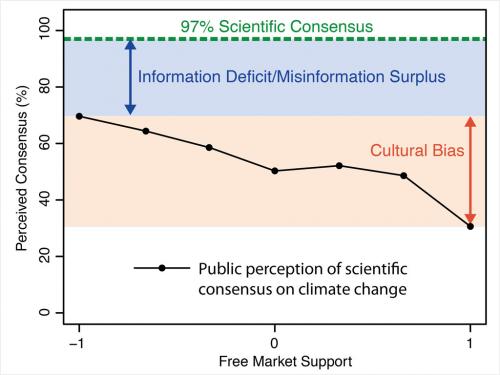An externally-valid approach to consensus messaging
Earlier this week, Dan Kahan published a blog post questioning the value of consensus messaging. He generously allowed me to publish a guest post, An "externally-valid" approach to consensus messaging, responding to his issues. For starters, I examine Dan's idea that the consensus gap (the gap between public perception and the 97% consensus) is due to cultural cognition. I point out that there is a consensus gap even among liberals:
A 2012 Pew surveys of the general public found that even among liberals, there is low perception of the scientific consensus on human-caused global warming. When Democrats are asked “Do scientists agree earth is getting warmer because of human activity?”, only 58% said yes. There’s a significant "consensus gap” even for those whose cultural values predispose them towards accepting the scientific consensus. A “liberal consensus gap”.
My own data, measuring climate perceptions amongst US representative samples, confirms the liberal consensus gap. The figure below shows what people said in 2013 when asked how many climate scientists agree that humans are causing global warming. The x-axis is a measure of political ideology (specifically, support for free markets). For people on the political right (e.g., more politically conservative), perception of scientific consensus decreases, just as cultural cognition predicts. However, the most relevant feature for this discussion is the perceived consensus on the left.

At the left of the political spectrum, perceived consensus is below 70%. Even those at the far left are not close to correctly perceiving the 97% consensus. Obviously cultural cognition cannot explain the liberal consensus gap.
So if cultural cognition can't fully explain the consensus gap, what else has contributed?
A clue to the answer lies with a seasoned communicator whose focus is solely on “externally valid” approaches to messaging. To put past efforts at consensus messaging into perspective, reflect on these words of wisdom from Republican strategist and messaging expert Frank Luntz on how to successfully communicate a message:
“You say it again, and you say it again, and you say it again, and you say it again, and you say it again, and then again and again and again and again, and about the time that you're absolutely sick of saying it is about the time that your target audience has heard it for the first time. And it is so hard, but you've just got to keep repeating, because we hear so many different things — the noises from outside, the sounds, all the things that are coming into our head, the 200 cable channels and the satellite versus cable, and what we hear from our friends.”
When it comes to disciplined, persistent messaging, scientists aren’t in the same league as strategists like Frank Luntz. And when it comes to consensus, this is a problem. Frank Luntz is also the guy who said:
“Voters believe that there is no consensus about global warming in the scientific community. Should the public come to believe that the scientific issues are settled, their views about global warming will change accordingly. Therefore, you need to continue to make the lack of scientific certainty a primary issue in the debate, and defer to scientists and other experts in the field.”
Luntz advocated casting doubt on the consensus for one simple reason. When people understand that scientists agree that humans are causing global warming, then they’re more likely to support policies to mitigate climate change. Confuse people about consensus, and you delay climate action.
Lastly, I finish with some wonderful excerpts from a must-read paper by Ed Maibach:
Reflecting on the disinformation campaign and the social science research into consensus messaging, Ed Maibach at George Mason University incorporates both the “internally valid” social science research and the “externally valid” approach of Frank Luntz:
We urge scientific organizations to patiently, yet assertively inform the public that, based on the evidence, more than 97% of climate experts are convinced that human-caused climate change is happening. Some scientific organizations may argue that they have already done this through official statements. We applaud them for their efforts to date, yet survey data clearly demonstrate that the message has not yet reached or engaged most Americans. Occasional statements and press releases about the reality of human-caused climate change are unfortunately not enough to cut through the fog—it will take a concerted, ongoing effort to inform Americans about the scientific consensus regarding the realities of climate change.
How do we achieve this? Maibach suggests climate scientists should team up with social scientists and communication professionals. What should scientists be telling the public? Maibach advises:
In media interviews, public presentations, and even neighborhood and family gatherings, climate scientists should remember that many people do not currently understand that there is an overwhelming scientific consensus about human-caused climate change. Tell them, and give them the numbers.
The book Made To Stick looks at “sticky” messages that have caught the attention in the public’s eyes. It runs through many real-world case studies (e.g., externally valid examples) to demonstrate that sticky ideas are simple, concrete, unexpected and tell a story. For a general public who think there is a 50:50 debate among climate scientists, learning that 97% of climate scientists agree that humans are causing global warming ticks many of the sticky boxes.
Posted by John Cook on Saturday, 21 June, 2014


